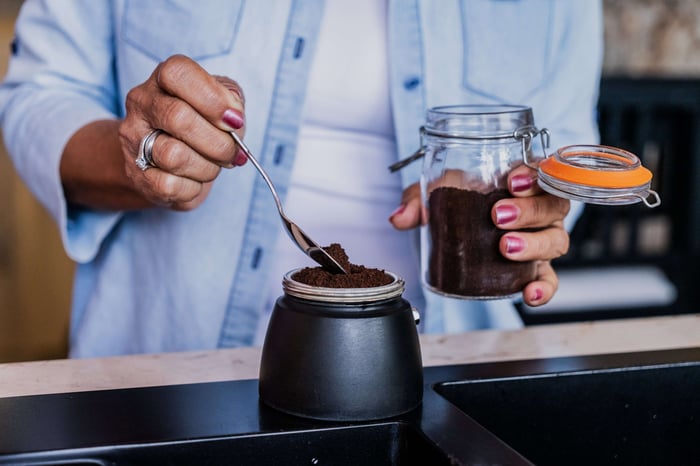Finding the right coffee grind size is essential for making a perfect cup of coffee. The grind size affects the extraction rate, flavor, and texture of your brew. If the coffee grind is too fine or too coarse for your chosen brewing method, it can lead to over-extraction, under-extraction, or a lack of balance in taste. Understanding the best coffee grind size for different brewing methods ensures that each cup is brewed to perfection.
Why Grind Size Matters
Grind size influences how water interacts with coffee grounds, affecting extraction and flavor. A finer coffee grind increases surface area, allowing water to extract flavors quickly, which is ideal for espresso but too strong for French press brewing. Conversely, a coarser grind slows extraction, perfect for immersion methods but too weak for espresso.
Grind Sizes and Their Uses
Each brewing method requires a specific grind size for optimal extraction. Below are the most common grind sizes and their best applications:
Extra Coarse Grind
Texture: Similar to coarse sea salt or peppercorns
Best for: Cold Brew, Cowboy Coffee
Why it Works: Cold brew requires extended steeping times, and an extra coarse grind allows for slow extraction without over-extracting, which could lead to bitterness.
Coarse Grind
Texture: Comparable to coarse sea salt
Best for: French Press, Percolators, Cupping
Why it Works: A coarse grind prevents excessive sediment in French press brewing while allowing the water to fully interact with the grounds over a longer steep time.
Medium-Coarse Grind
Texture: Similar to rough sand
Best for: Chemex, Clever Dripper, Café Solo Brewers
Why it Works: A medium-coarse grind ensures even extraction while preventing over-extraction, which can lead to bitterness in pour-over methods that require a slower water flow.
Medium Grind
Texture: Similar to beach sand
Best for: Drip Coffee Makers, Siphon Brewers, Aeropress (with longer steep time)
Why it Works: This grind size balances water flow and extraction, producing a clean and flavorful cup.
Medium-Fine Grind
Texture: Slightly finer than sand
Best for: Pour-Over (Hario V60, Kalita Wave), Aeropress (short steep time)
Why it Works: A medium-fine coffee grind allows better control over extraction, making it suitable for methods that rely on precise water flow.
Fine Grind
Texture: Similar to powdered sugar or table salt
Best for: Espresso, Moka Pot
Why it Works: A fine grind enables rapid extraction under high pressure, which is necessary for espresso and stovetop espresso makers.
Extra Fine Grind
Texture: Powder-like, almost like flour
Best for: Turkish Coffee
Why it Works: Turkish coffee requires ultra-fine grind to create a thick, rich consistency when brewed in an ibrik.
How to Adjust Your Grind for Better Results
Even with the right grind size, small adjustments may be needed based on factors like coffee bean type, roast level, and environmental conditions. Here’s how to fine-tune your grind for better consistency:
1. Consider Brew Time
A longer brew time generally requires a coarser grind, while shorter brew times work best with a finer grind. If coffee tastes too bitter, the grind may be too fine, leading to over-extraction. If it tastes weak or sour, the grind might be too coarse, causing under-extraction.
2. Adjust for Flavor Preferences
While each brewing method has a recommended coffee grind size, personal taste preferences play a role. Some coffee drinkers prefer a slightly coarser grind for a lighter flavor or a finer grind for a more intense taste.
3. Test and Modify
If your coffee tastes off, making small adjustments to the grind size can improve flavor. Try changing the grind one step finer or coarser and observe how it affects the taste.
Adjustable Burr Coffee Grinder
Choosing the Right Grinder
The type of grinder you use also impacts the consistency of your coffee. Here are two main types of coffee grinders and their benefits:
Burr Grinder (Recommended)
Provides a consistent coffee grind size
Allows for precise adjustments
Produces uniform particles for even extraction
Blade Grinder
Chops beans unevenly, leading to inconsistent coffee grind
Requires manual shaking to improve grind uniformity
Less control over grind size
A burr grinder is the best option for achieving a consistent grind, resulting in a better-tasting cup.
Storing Ground Coffee for Freshness
To maintain freshness, store ground coffee properly:
Use an airtight container
Keep it in a cool, dark place
Avoid exposure to moisture and heat
Grind beans just before brewing for the best flavor
Final Thoughts
Finding the correct coffee grind size for each brewing method significantly impacts the flavor and quality of your coffee. By selecting the appropriate grind size and making small adjustments as needed, you can brew coffee that matches your taste preferences. Investing in a quality burr grinder and proper storage practices will further enhance the consistency and freshness of your coffee grind. Whether making cold brew, espresso, or a classic French press, understanding grind size is key to crafting a satisfying cup.

